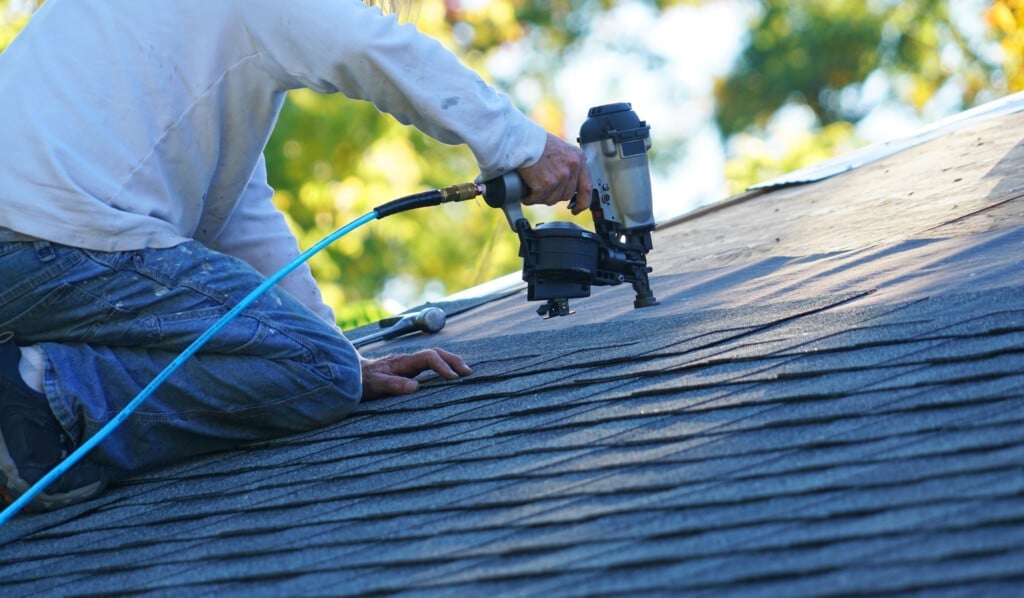17 Roof Repair Tips That Can Save You Money
Roof repairs are often an unavoidable task for homeowners. While you may not be able to fix every problem that arises yourself, there are minor roof repairs that you can implement. And although you may need to call in professionals for more extensive issues or projects, you can rely on these easy roof repair tips to save you money.

Read on for more information on making minor roof repairs, maintenance, and tips on protecting your cash for another day.
1. Do Routine Checks
Keep an eye on your roof to prevent getting surprised by a sudden repair job. Of course, you can’t predict everything, but you can take some preemptive steps to keep repairs and costs low. For example, after nasty weather such as a tornado, hailstorm, or high levels of winds, take a peek at your roof and make sure nothing has become damaged.
2. Perform Regular Maintenance
To prevent the need for major repairs or replacements that will break the bank, make sure to keep your roof maintained. You can either maintain it yourself or hire a professional commercial roofing company to do it for you. Draw up a detailed maintenance plan and make sure to keep on top of any routine tasks, cleaning, and repairs that your roof requires, costing you less money in the long run.
3. Don’t Let it Get Out of Hand
Try not to let roof repairs slide—the more damage is built up, the more effort and money will inevitably go into fixing it. If you notice an issue with your roof, it’s best to deal with it as soon as possible instead of putting it off.
4. Know When to Replace vs. Repair
There are just some things that you cannot fix, no matter how hard you try. If faced with a problem that cannot be repaired, know when to accept it. Replacing roofing parts may be more expensive than fixing them up, but in the long run, having a reliable roof over your head is worth it. If only isolated portions of your roof are having issues, you can certainly do a quick repair job, but if you are experiencing more extensive problems or damage, it may be time for a replacement.
5. Be Safe
It might seem obvious, but if you plan to get roof repairs done yourself, make sure that you are prepared and safe. Wear safety gloves, long pants, and a long-sleeved shirt when making any repairs, and try to go onto the roof during an overcast day to avoid dehydration, heatstroke, or sunburn. Additionally, wear rubber-soled shoes when on the rooftop; rubber soles provide you with good traction to prevent slipping and falling—and a potentially expensive and stressful trip to the hospital.
6. Know When to Call in the Professionals
It’s good to know when to call in the pros —some home roofing projects just should not be handled by the average homeowner, and that’s alright! It’s important to know your limits. When you can’t figure out how to fix a problem with your roof, or you don’t have the time or necessary skills or tools to do so, call in the professionals. Most contractors and roofing companies will give you a free repair quote for the work that needs to be done to provide you with a better idea of how long it will take and the cost.
7. Find the Right Roofing Contractor
For any major repairs or replacements, make sure to research local contractors and find the best one for the job. Choosing the right contractor saves you money by having the job done correctly, the first time, and with fewer problems.
8. Use Quality Materials
When making any repairs to your roof, do not skimp on the quality of the products or materials. It might be tempting to cut some costs by using cheaper goods, but make sure to focus on getting the best materials possible to ensure that you repair the problem areas well and avoid future issues.
9. Prevent Rust
To prevent having to replace your nails and shingles more frequently, make sure to use nails made out of aluminum or galvanized steel. Because your roof is the first line of defense against the weather, the materials are exposed to the elements. So any metals used there need to be rust-proof. While it may seem like a small thing, repairing the damage done by rusty nails and corrosion will be a major hassle and will add up quickly.
To make your nails extra secure, pop some caulk or roof sealant over the nail heads and give yourself some peace of mind.
10. Avoid Flat Roofs
It might seem like a flat roof is easier to keep maintained, but that is certainly not the case. Flat roofs are more prone to water pooling and weight damage, so you need to keep an eye out for that. If you find issues arising with water damage to your roof, remove the damaged material and apply a heavy layer of roofing cement, a new batch of the material, and a solid row of protected roofing nails to give the roof the most support possible.
If the damage is severe, don’t wait—call in a professional who can use the correct tools to get repairs done quickly and for the right price.
11. Get Good Gutters
Gutters are just as much a part of the roof as shingles, so regularly cleaning them out will help identify problems with the roofing, especially where the gutter hardware attaches. If your gutters become too clogged with natural debris, granules, or bits of shingles, they will not be able to transport water runoff properly, and you run the risk of overflow and flooding the foundation of your home.
Similarly, clogged gutters are heavy, and put unnecessary strain on the roofing components, so keep them clean!
12. Keep an Eye Out for Leaks
Prevent flooding, electrical damage, and more by simply keeping your eyes peeled. Check your roof for signs of leakage, loose shingles, or cracked caulk before the issue becomes insurmountable. You want to get ahead of problems before your entire home and family are negatively affected by them!
13. Pay Attention to the Flashing and Vents
If your roof’s flashing has gaps in it or has become loose, you need to secure it to the roof with nails and roof cement to avoid any leakage. Replace any fractured caulk immediately, or apply roof cement to smaller cracks. Don’t forget to seal around all the vents in the roof and the chimney to keep everything watertight. If a bad storm has caused debris to fall onto your roof, check the caulking to ensure no cracks have formed that will generate more extensive problems later.
14. Salvage What You Can
Home repairs can get expensive, and roofs are no different—try to do what you can to salvage anything that isn’t completely broken. For example, save old shingles to avoid buying new ones or ending up with mismatched shingles later on. Additionally, you can typically reuse the metal support hardware on your roof for many years just by replacing screws and keeping it well maintained.
15. Save the Shingles
A common problem that people encounter with their roofing has to do with shingles. Sometimes, they will curl or become brittle, causing them to lift from the roof surface and not do their job properly. In this case, you don’t have to replace your entire roof necessarily—you can use roofing cement and roofing nails to keep curled shingles down, and if they are brittle, try softening them with a heat gun and pressing them back into the roofing.
16. Schedule for Spring
Because temperature fluctuations and weather significantly affect the structural integrity of your roof, including shingles, flashing, and joints, winter can be rough on roofing. When any snow has had a chance to melt, and constant precipitation is no longer an issue in the spring, examine your roof: are the shingles getting loose, or is the caulking beginning to flake?
Use the warmer weather to check your roof and get a head start on any fixes before the summer months when contractors’ rates commonly go up for roof repairs, just in case you need some outside help and don’t want to break the bank.
17. Read the Fine Print
If you are faced with some significant repairs, make sure to check the roof’s warranty. Newer homes will likely still have a warranty left on the roof so that you can take advantage of those savings. Additionally, check the municipal and state laws regarding home maintenance—make sure that your repairs will still be within all current codes and roofing perimeters, saving yourself time and money on repairs that might have to be redone or altered to code.
For more helpful information on how to maintain your home, check out our blog on solar panel maintenance.



